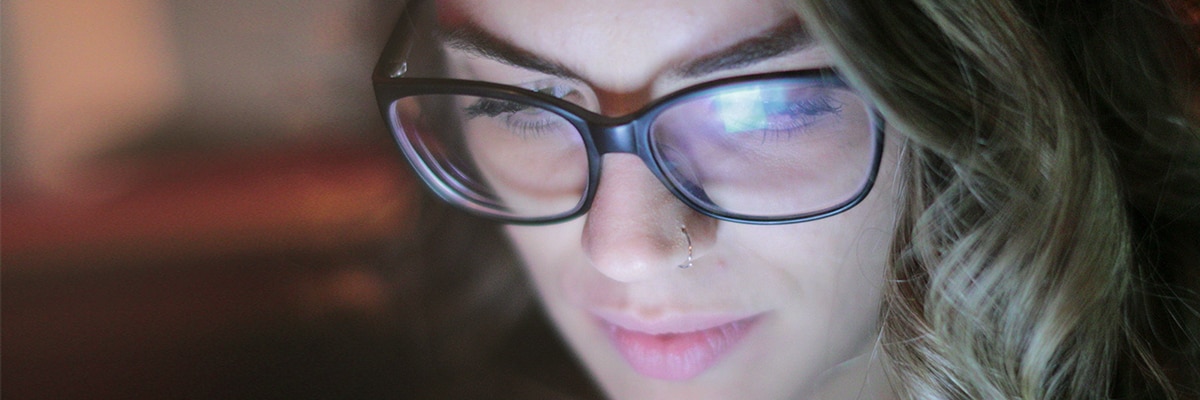In the EBD Blog
We’ve never really experienced a world quite like the one we’re living in today. Concepts like social distancing, self-isolation and vigorous hand-washing are at the top of everyone’s minds — and rightfully so.
As a result, we’re all spending a lot more time indoors with our eyes fixed on phones, TVs and computers. Naturally, this can have an effect on our physical health, and in particular, the well-being of our eyes.
Getting creative with simple things like taking consistent screen breaks, trying blue light blocking glasses and adding health-conscious foods to your diet can improve visual comfort and make cooped-up living more enjoyable.
Students don’t have to be the only ones homeschooling right now. Think of self-isolation as your opportunity to learn something new and incorporate healthier habits into your life.
Reward your eyes for their hard work
This isn’t an easy time to be an eyeball. Increased screen usage and less natural light can put a strain on the eyes at any age.
Digital eyestrain, also called computer vision syndrome, can happen when you overload on digital screen time. Symptoms are usually temporary, but can be uncomfortable and even painful. Treat digital eyestrain before it strikes and you could drastically reduce the blurry vision, dry eyes and headaches that go hand in hand with this condition.
The 20-20-20 rule is one popular way to avoid the symptoms of digital eyestrain. Its beauty lies in its simplicity:
Every 20 minutes, look at an object at least 20 feet away for at least 20 seconds.
Focusing on a distant object relaxes the tiny eye muscles that tire out after too much screen time. If eyesight was yoga, the 20-20-20 rule would be child’s pose.
Plus, it’s a great opportunity to cut back on artificial screen lighting for a moment. Instead of looking at a distant TV, try a tree outside your window or a houseplant on the opposite side of the room.
The same method applies for children — kids can experience eyestrain just like adults. Encouraging the 20-20-20 rule during this period of self-isolation can help them prepare for a lifetime of screen use.
Taking longer screen breaks is just as important as short pauses. If you find yourself in front of a screen for a while, take an extended break to read a book, work on a jigsaw puzzle, play a round of solitaire (with a real deck of cards), or call a friend or family member (without using FaceTime). Five or 10 minutes can make all the difference.
Experiment with different glasses
Blue-light glasses, also called computer glasses, have been gaining popularity as a method of reducing the effects of digital eyestrain.
These glasses specifically block high-energy visible (HEV) light, a blue-violet portion of the visible light spectrum. It’s emitted by most electronic screens and can cause discomfort and even potential damage to your eyes.
The lenses of blue-light glasses often appear clear, but can seem ever so slightly tinted yellow to the wearer. This yellow color counters blue light and relaxes the eyes. Since your brain can mix up screen light with sunlight, blocking blue light before bedtime can even help regulate your sleep schedule.
Additionally, most phones and computers now come with a setting that yellows the screen, further reducing that blue light intake. There are several free apps and programs that also offer the same effect.
Add eye-friendly foods to your shopping list
For the first time in many of our lives, crossing off everything on the grocery list may have become a challenge. Supermarkets around the globe are experiencing different levels of shortages, at least for the time being.
With that in mind, your diet still plays a big role in your vision, as it does in so many other aspects of your physical health.
Carrots out of stock? That’s okay, you can still shop with your eyes in mind.
When you think of eye-friendly foods, you might think of vitamin A. It’s hard to top carrots in this category, but sweet potatoes, butternut squash and spinach also have an abundance of this vision-boosting vitamin.
Vitamin A pairs with zinc like wine goes with cheese. Zinc intake helps your body absorb more vitamin A, and it can also help your immune system function more efficiently. Optimizing your immune system with nutritious whole foods and exercise, combined with practices like social distancing, provides an added barrier when leaving your house is necessary.
During times like these, leaning on macaroni and cheese or canned spaghetti can be tempting. Add a few of these foods to your diet and your eyes will thank you:
- Foods rich in vitamin E: Whole grain cereal, nuts (especially almonds and hazelnuts) and spinach.
- Foods rich in certain antioxidants: Blueberries, artichokes and “real” dark chocolate with high cacao (or cocoa) content.
- Foods rich in omega-3s, especially EPA and DHA: Coldwater fish such as salmon, mackerel, herring and tuna; or flax seeds or flaxseed oil as a vegetarian alternative (although these lack the EPA and DHA of fish).
Our eyes’ role in COVID-19
You’ve probably already heard that the novel coronavirus can be transmitted through the eyes, which was confirmed by the Centers for Disease Control and Prevention (CDC). This is one of the reasons you see photos of health care professionals wearing not only facemasks, but protective goggles or face shields too.
The eyes are far from the most common methods of spread (inhaled respiratory droplets and person-to-person distance of less than six feet) but that doesn’t downplay the importance of keeping your hands away from your face. This is even more important for your nose and mouth.

